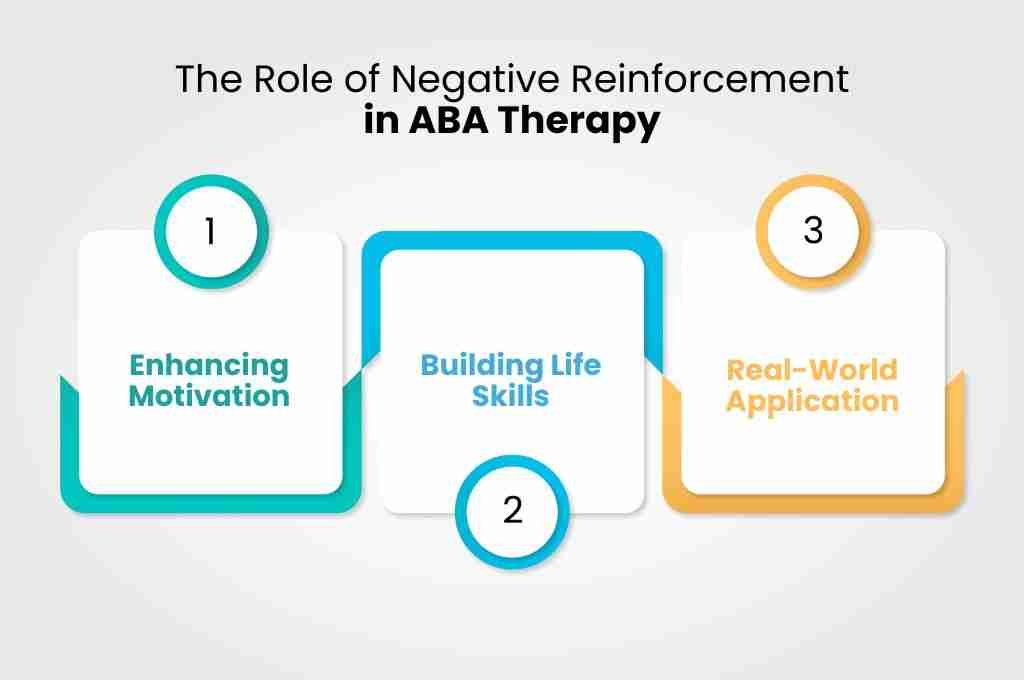Negative Reinforcement in ABA Therapy: Understanding Its Role and Impact
ABA TherapyJuly 17, 2025

Applied Behavior Analysis (ABA) therapy is a widely recognized approach for supporting individuals with autism and other developmental disorders. One of the key concepts within ABA is reinforcement, which can be categorized into positive and negative reinforcement.
While many people are familiar with positive reinforcement—adding a pleasant stimulus to encourage behavior—negative reinforcement often raises questions.
In this article, we will delve into negative reinforcement in ABA therapy, clarify common misconceptions, and provide practical insights for parents and practitioners.
What is Negative Reinforcement?
Negative reinforcement involves the removal of an unpleasant stimulus to increase the likelihood of a desired behavior. It is essential to clarify that negative reinforcement is not punishment; instead, it aims to strengthen behaviors by eliminating negative conditions.
For example, if a child completes their homework (desired behavior), they may be allowed to skip chores (removal of an unpleasant stimulus).
The Mechanics of Negative Reinforcement

To understand how negative reinforcement works, consider the following components:
- Behavior: The action taken by the individual.
- Unpleasant Stimulus: The aversive condition that is present before the behavior occurs.
- Removal of Stimulus: The unpleasant condition is removed after the desired behavior is exhibited.
This process can be illustrated with a simple chart:
Behavior
Unpleasant Stimulus
Result
Completes homework
Chores
Chores are removed
Uses polite language
Teasing
Teasing stops
Common Misconceptions
Despite its effectiveness, negative reinforcement is often misunderstood. Here are some common misconceptions:
- Myth 1: Negative reinforcement is the same as punishment.
- Reality: While punishment aims to decrease undesirable behavior through adverse consequences, negative reinforcement seeks to increase desirable behavior by removing negative conditions.
- Myth 2: Negative reinforcement is harmful.
- Reality: When applied correctly in ABA therapy, negative reinforcement can lead to positive behavioral changes without causing distress or harm.
The Role of Negative Reinforcement in ABA Therapy -
In ABA therapy, negative reinforcement can be a powerful tool for encouraging positive behaviors. Here’s how it plays a role:

Enhancing Motivation
By removing aversive stimuli when a child exhibits desired behaviors, therapists can enhance motivation. For instance, if a child who struggles with anxiety learns that participating in group activities will reduce their anxiety (the unpleasant stimulus), they may be more likely to engage in those activities.
Building Life Skills
Negative reinforcement can also help build essential life skills. For example, teaching a child to use appropriate communication can lead to fewer instances of frustration (the unpleasant stimulus). Once they learn this skill, the frustrating situations are minimized, reinforcing their communication efforts.
Real-World Application
Here’s an example of how negative reinforcement might be applied in a real-world scenario:
Scenario: A child with autism frequently refuses to participate in social activities due to anxiety.
- Identify Behavior: Participation in social activities.
- Identify Unpleasant Stimulus: Anxiety or discomfort from social interactions.
- Implement Negative Reinforcement: Gradually expose the child to social situations while providing support and reassurance. Once they participate successfully, reduce the level of support (removal of anxiety-inducing factors).
This approach not only encourages participation but also helps the child develop coping mechanisms for anxiety.
Practical Tips for Implementing Negative Reinforcement
To effectively implement negative reinforcement in ABA therapy, consider the following tips:
- Be Clear About Expectations: Ensure that the child understands what behavior will lead to the removal of the unpleasant stimulus.
- Use Gradual Exposure: Start with less challenging situations and gradually increase difficulty as the child becomes more comfortable.
- Monitor Progress: Keep track of behaviors and their outcomes to assess whether negative reinforcement is effective.
- Incorporate Positive Reinforcement: Use positive reinforcement alongside negative reinforcement for a balanced approach that encourages overall growth.
- Communicate with Caregivers: Collaborate with parents and caregivers to ensure consistency between therapy sessions and home environments.
Conclusion
Negative reinforcement is an essential component of ABA therapy that can foster positive behavioral changes when applied thoughtfully and consistently. By understanding its mechanics and implementing it effectively, therapists can help individuals overcome challenges and develop essential life skills.
As you explore this concept further, remember that every individual is unique; what works for one may not work for another. Stay patient and flexible in your approach, and always prioritize the well-being of those you support.
For more insights on ABA therapy techniques or personalized guidance tailored to your child's needs, feel free to reach out to our team at Illuminate ABA Therapy!
Get More Insights: Managing Tantrums in Children with Autism


